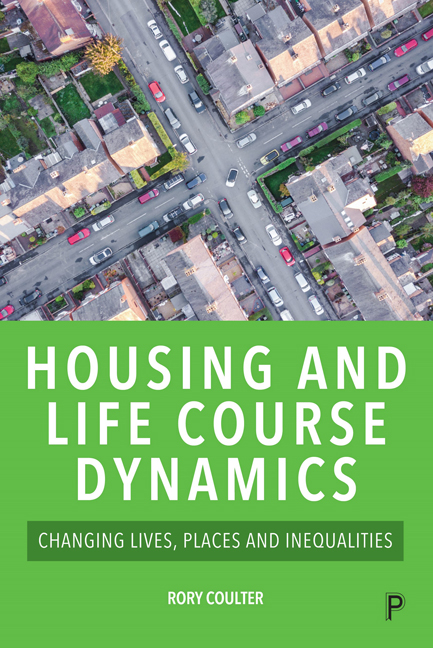Book contents
- Frontmatter
- Dedication
- Contents
- List of figures and tables
- List of abbreviations
- Notes on the author
- Acknowledgements
- Preface
- 1 Introduction
- 2 Housing: a life course perspective
- 3 Households and families
- 4 Learning and training
- 5 Employment and money
- 6 Health, well-being and care
- 7 Changing places
- 8 Understanding housing and life course dynamics
- Notes
- References
- Index
3 - Households and families
Published online by Cambridge University Press: 18 January 2024
- Frontmatter
- Dedication
- Contents
- List of figures and tables
- List of abbreviations
- Notes on the author
- Acknowledgements
- Preface
- 1 Introduction
- 2 Housing: a life course perspective
- 3 Households and families
- 4 Learning and training
- 5 Employment and money
- 6 Health, well-being and care
- 7 Changing places
- 8 Understanding housing and life course dynamics
- Notes
- References
- Index
Summary
This chapter examines the connections between housing careers and the dynamics of households and families. As Chapter 2 explained, Rossi (1955) was the first to recognise that family dynamics play a pivotal role in structuring housing careers. Decades of subsequent research have supported Rossi's thesis that events in the family life course frequently generate new residential demands which then prompt housing adjustments (Clark, 2021).
However, this prevailing focus on how family processes drive housing careers provides only a partial view of how these two life course domains interact. For a start, causality can flow in the other direction as housing opportunities and constraints impinge on family dynamics, for example the choice to have children (Mulder, 2006). More fundamentally, housing moves and housing-related support practices also actively reshape kin relations (Holdsworth, 2013). Housing and family therefore constitute such deeply intertwined careers that neither can be fully understood in isolation.
Changing families
Changes in housing behaviour are deeply bound up with the ongoing transformation of households and families that has occurred with the post-war demographic restructuring of Global North societies. Broadly speaking, population change since the Second World War has influenced family dynamics in two ways. First, new family behaviours and patterns of domestic living arrangement have emerged as countries have moved through the Second Demographic Transition (Lesthaeghe, 2010). To illustrate this process, Table 3.1 compares data on family-related behaviours and household structures in England and Wales from two census years: 1951 and 2011. The table highlights several trends, including:
• delayed marriage and the emergence of unmarried cohabitation, most notably among younger couples for whom cohabitation is now both an alternative to marriage as well as the normal precursor to it;
• increased partnership instability since the 1960s driven partly by higher divorce rates and partly by the replacement of marriages with less stable cohabitations;
• declining fertility due to postponed childbearing and lower levels of completed fertility;
• the decoupling of childbearing from marriage;
• reductions in average household size associated with ageing, lower fertility and increased solo living (ONS, 2014).
These trends have been accompanied by the growth of reconstituted or ‘blended’ families and an increase in the proportion of children dividing their time between the households of separated parents. Greater acceptance of same-sex partnerships and their legal recognition from 2005 have injected further variety into family structures.
- Type
- Chapter
- Information
- Housing and Life Course DynamicsChanging Lives, Places and Inequalities, pp. 52 - 75Publisher: Bristol University PressPrint publication year: 2023



